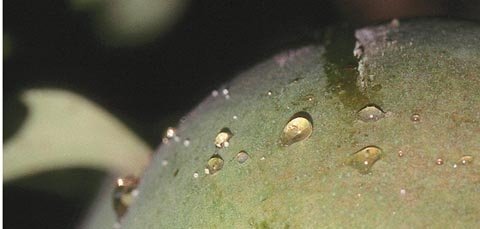
A close-up view of psylla honeydew droplets on fruit surface.
The most effective time to control pear psylla is early in the season, Washington State University entomologist Dr. John Dunley stresses. The pest develops through five or six generations in the Wenatchee Valley, a major pear-growing region.
The emergence of the pest in the spring is synchronized with the development of the tree, rather than the weather, Dunley said. Overwintering adults don’t lay eggs until green tissue starts to develop so that the nymphs that hatch are likely to have something to feed on. Getting rid of sucker crowns during pruning will help reduce pear psylla habitat and improve spray coverage.
Adults
The delayed-dormant season is the time to target adults with Surround (kaolin) to chase adults out of the orchard and deter egg laying. Because psylla moves around from orchard to orchard, an areawide approach works well.
Prebloom, eggs are laid on fruit spurs and wood near fruit spurs. This is the best time to apply insect growth regulators, which affect the eggs and young instars. The prebloom timing also ensures better coverage of the tree. Later in the season, it’s more difficult to reach the psylla because of the foliage.
Eggs start to hatch around cluster bud stage, and peak egg hatch is around petal fall. The young nymphs are pale yellow at first, but turn darker as they mature. They have no wings. The third, fourth, and fifth instars have visible wing pads and hard shells. The hard shell affects the ability of pesticides to impact the older nymphs.
A key target time for controlling pear psylla is about two weeks after petal fall when the nymphs are mainly in the first and second instars, with a few at the third-instar stage. By the second and subsequent generations, life stages overlap.
“That’s why it’s important we hit the first generation hard, because the life stages are synchronized,” Dunley said.
“With good control of the first generation, the second generation will be better synchronized.”
Pear psylla must be controlled both pre- and postbloom to be successful and avoid problems for the rest of the season, he said.
Nymphs have long stylets that they insert into leaves to feed on the phloem of the tree. They prefer to feed on vigorously growing parts of the tree, and that means they often feed on sucker crowns—parts of the tree that are difficult to reach with pesticides. Dunley recommended pulling suckers to get better spray coverage and to reduce the need for multiple applications.
Nymphs need to process a lot of fluid from the tree to get enough nutrition. In extreme cases, feeding can affect tree health and lead to pear decline or even kill the tree. Honeydew is the excess fluid and sugar that the insects excrete and serves to protect them from natural enemies and pesticides. Honeydew on fruit attracts sooty mold and can cause russeting and downgrading of the fruit.
The second generation generally develops in June and the third in late June to early July, Dunley said. The adult has two forms—a summer form, and a winter form, which is larger, fatter, and darker. By late fall, winter-form adults will develop and start feeding in preparation for diapause.

Leave A Comment